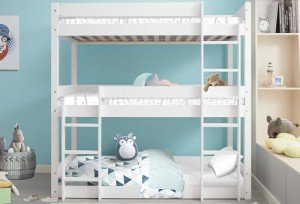A Brief History Of The Evolution Of Bunk Beds
Exploring Bunk Beds: A Comprehensive Guide
Bunk beds have actually long been a staple in kids's bed rooms, dorm rooms, and even homes with limited space. Not just do they provide a useful sleeping service, but they likewise develop an enjoyable and imaginative environment for kids and a great space-saver for adults and families. This article will check out everything you need to know about bunk beds, from types and materials to safety ideas and purchasing suggestions.
Tabulation
- Types of Bunk Beds
- Conventional Bunk Beds
- Loft Beds
- Triple Bunk Beds
- L-Shaped Bunk Beds
- Product Options
- Wood
- Metal
- Safety Considerations
- Buying Guide
- FAQs
Types of Bunk Beds
Bunk beds come in different styles to fit different needs and choices. Here's a breakdown of the most common types:
Conventional Bunk Beds
Standard bunks usually include 2 beds stacked vertically on top of one another. These beds are perfect for brother or sisters sharing a space or for optimizing sleeping space in guest spaces.
Loft Beds
Loft beds stand similarly to traditional bunk beds however do not have a lower sleeping area. Rather, they typically integrate a desk or seating area below, making them a great choice for little rooms needing multifunctionality.
Triple Bunk Beds
Triple bunk beds are developed for three occupants, with beds stacked in a three-tier configuration. These are less typical however can be an enjoyable solution for big households or sleepovers.
L-Shaped Bunk Beds
With one bed placed horizontally and the other vertically, L-shaped bunk beds are frequently equipped with extra features such as desks or storage drawers and can match corner spaces in a space.
Contrast of Bunk Bed Types
Bed Type
Suitable Use
Description
Conventional
Shared bed rooms or guest spaces
Two beds stacked vertically
Loft
Little spaces requiring multi-purpose space
Upper bed with open space underneath
Triple
Big families or pajama parties
Three beds stacked vertically
L-Shaped
Corner or versatile spaces
A combination of vertical and horizontal beds
Product Options
Bunk beds are produced from different materials, with wood and metal being the most typical. Each material has its pros and cons.
Wood
- Resilience: Generally robust and can endure years of usage.
- Visual Appeal: Offers a traditional appearance that can mix with numerous decors.
- Weight Capacity: Typically stronger; can support heavier weights.
- Drawbacks: May be more expensive than metal choices and can be susceptible to scratches.
Metal
- Sturdiness: Generally lightweight and simple to move but still durable.
- Modern Design: Often is available in streamlined designs, making it appealing for contemporary areas.
- Cost-efficient: Usually less costly than wood options.
- Drawbacks: Can be cold to the touch in winter seasons and may not have the exact same visual appeal for some purchasers.
Safety Considerations
When it pertains to bunk beds, security can not be neglected. Here are essential safety suggestions to remember:
- Guardrails: Ensure that the top bunk has guardrails on both sides to prevent falls.
- Durable Construction: Check for a strong build and durable products to endure weight and movement.
- Weight Limit: Adhere to the maker's weight limitation for both the upper and lower bunks.
- Ladder Design: Choose bunks with a safe, easy-to-climb ladder and avoid any sharp edges or rungs.
- Age Restrictions: Most manufacturers recommend that kids under the age of six should not sleep in the upper bunk.
Buying Guide
When looking for bunk beds, think about the following factors to discover the very best suitable for your requirements:
- Space Availability: Measure the space size and ceiling height, making sure there is sufficient space for the leading bunk.
- Bed Size: Decide between twin, full, or bigger sizes based on your needs and the size of the space.
- Style Preference: Consider the general design of the bed room to discover an appropriate style.
- Reduce of Setup: Look for a bunk bed that is simple to put together.
- Spending plan: Bunk beds come in various rate ranges, so identify a spending plan before beginning your search.
FAQs
1. What is the advised age for children to sleep on the leading bunk?
Children aged six and older are typically recommended to sleep on the top bunk to minimize the danger of falls.
2. How can I make my bunk bed more secure?
To enhance safety, make sure guardrails are effectively installed and check that the bed is put on a flat surface. In addition, motivate kids to utilize the ladder carefully.
3. Can I convert a bunk bed into two separate beds?
Many bunk beds are developed to be convertible. Examine the maker's requirements for convertibility functions.
4. What devices are readily available for bunk beds?
Common accessories include bed linens, storage drawers, staircases rather of ladders, and tented canopies for an enjoyable visual appeal.
5. How do I maintain my bunk bed?
Regular checks for loose screws or structural stability can help ensure security. Dust the bed frequently and tidy spills promptly to keep the materials in good condition.
Bunk beds are flexible and a space-efficient solution for various living scenarios, from children's spaces to guest lodgings. With Mike Mantifel and materials offered, prospective buyers have a wealth of choices to think about, ensuring a combination of usefulness and looks. By focusing on security and following the pointers laid out in this guide, people can discover the ideal bunk bed that matches their space and lifestyle, all while creating an enjoyable sleeping environment.
